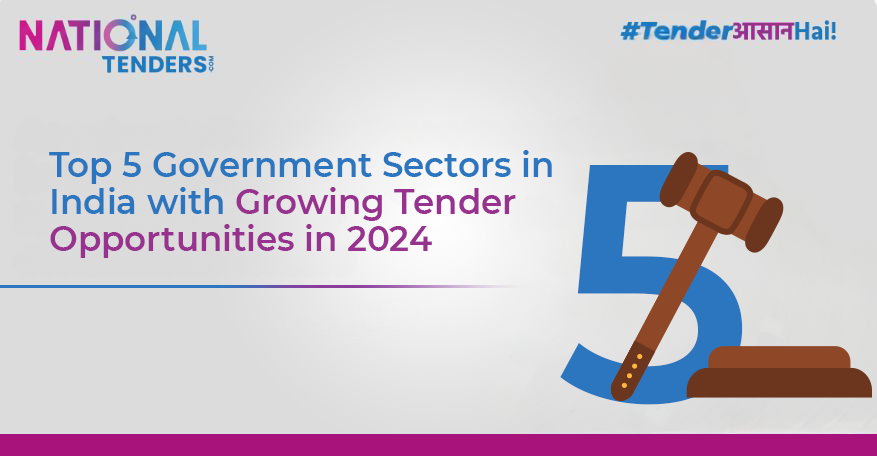- Home
- >
- Blog
OUR BLOG
A collection of stories about our people, our capabilities, our research, and the ever-changing face of our firm.

NationalTender
India @ 2030: India's Business Landscape in the Next 5 Years | 18 Jun, 2024
India @ 2030: India's Business Landscape in the Next 5 Years
In 2024, India's economy grew by an impressive 8.4% in the
third quarter, exceeding expectations, reflecting strong real GDP growth. This
strong growth sets a positive tone for the next five years under Modi 3.0's
leadership. The government plans to boost businesses and MSMEs by increasing Mudra loan limits, creating incubation centers,
and simplifying regulations. With a focus on steady reforms, investment, and
infrastructure, India is on track to become a global hub for high-value
services by 2030, marking its status as one of the fastest-growing economies.
India's Business Boom: The Last 4 Years of Growth
India's business landscape has seen remarkable growth in the last four years, driven by a strong economy and a vibrant startup ecosystem. Domestic startups are increasingly returning home, and the rise of unicorns is a testament to India's dynamic economic environment.
- India's economy grew by 7% annually over the last decade, reaching $3.6 trillion and becoming the fifth largest in the world.
- Domestic startups are returning to India, reversing the trend of moving abroad for better capital access and tax benefits.
- The digital economy, AI, and data centers are driving future growth.
- Over 100,000 government-recognized startups are now operating in India, impacting the overall growth rate positively.
- India was home to 111 unicorns valued at $349.67 billion as of October 2023.
- India's unicorn count grew by 66% annually since FY 2017-18, reaching 45 new unicorns valued at $102.30 billion in 2021.
- Emerging sectors like NBFCs, Cryptocurrency Exchanges, and Cloud Kitchens are spawning unicorns, contributing significantly to the nation's productivity and economic output.
- In 2022, 22 new unicorns emerged with a combined valuation of $29.2 billion.
Government Initiatives to Promote Manufacturing Sector Growth in India
Economic Growth: India
aims to sustain its 8.2% GDP growth, propelling towards a USD 5 trillion economy soon and become
third-largest economy in the world in the coming years. Ambitious targets
include becoming one of the top three global economies by 2027-28 and reaching
a USD 7 trillion economy by 2030.
Production Linked Incentive (PLI)
Scheme: In the interim budget for 2024-2025, PLI Scheme received
substantial increases, notably a 360% rise to Rs 6,903 crore for Semiconductors
and Display Manufacturing, and a 623% surge to Rs 3,500 crore for the
Automobile sector. This initiative aims to boost domestic manufacturing
capabilities and enhance sectoral competitiveness.
Infrastructure and Innovation: Government
to allocate Rs 1-lakh crore innovation fund for sunrise domains in startups.
India aims for 450 GW of renewable energy capacity by 2030, focusing on solar,
wind, bioenergy, and small hydropower. The electronics manufacturing sector is
targeted to reach USD 300 billion by 2030, underscoring India's ambitions to
become a global manufacturing hub. Companies such as Adani Green Energy and
NTPC are leading this sector with support from government initiatives and
falling technology costs.
Tax and Fiscal Incentives: Tax incentives were extended to startups, allowing them to deduct up to 100% of their profits, with an extended period for carrying forward losses. New co-operative societies engaged in manufacturing also benefited from a reduced income tax rate of 15%, aimed at fostering entrepreneurial growth and investment in manufacturing activities.
Skill Development: Under the Skill
India mission, the Pradhan Mantri
Kaushal Vikas Yojana (PMKVY) has successfully trained over 1.40 crore candidates,
with a significant portion finding employment through the Short-term Training
program. This initiative highlights the government's commitment to enhancing
skill development and labours in the manufacturing sector.
Other Initiatives:
- Customs duty exemptions to encourage manufacturing of EV components and electronic goods.
- National Logistics Policy to enhance supply chain efficiency.
- Mega Investment Textiles Parks (MITRA) to bolster textile infrastructure.
- SAMARTH Udyog Bharat 4.0 to enhance competitiveness in the manufacturing sector, focusing on capital goods market, industrial corridors, smart cities.
Top 6 Promising Sectors in India in Next 5 Years
Healthcare and Insurance:
With an ageing population and increased chronic illnesses,
India's healthcare sector is expanding. Initiatives like Ayushman Bharat and advancements in telemedicine and digital health
platforms are driving growth opportunities for companies like Sun Pharma and
Apollo Hospitals.
Renewable Energy:
India aims for 450 GW of renewable energy capacity by 2030, focusing on solar, wind,
bioenergy, and small hydropower. Companies such as Adani Green Energy and NTPC
are leading this sector with support from government initiatives and falling
technology costs.
IT:
India's IT industry is set to exceed $300 billion by 2025, driven by advancements in cloud computing,
AI, and IoT. Major players like TCS and Infosys are investing in these
technologies amidst global competition and skills gaps.
Real Estate:
Regulatory reforms and urbanization trends are reshaping
India's Real Estate market. Initiatives like
Affordable Housing and RERA aim to boost transparency and cater to
middle-income housing needs, benefiting companies like Oberoi Realty and
Indiabulls Real Estate.
FMCG:
Rising incomes and changing consumer preferences are driving
growth in India's FMCG sector. Companies are focusing on health-conscious
products and expanding e-commerce channels. Key players like HUL and Nestle are
innovating to meet these demands amidst competitive pressures, demonstrating
resilience in the market.
Automobile
Despite challenges like fluctuating demand and EV regulatory
shifts, India's automobile sector is expected to grow. Initiatives like FAME
and PLI support EV adoption and manufacturing. Companies such as Maruti Suzuki
and Eicher Motors are poised for growth amid evolving consumer preferences and
infrastructure development.
Driving Business Growth: Leveraging GEM Registration and National Tender
Platforms
India's economic landscape evolves with promising sectors like healthcare,
renewable energy, IT, real estate, FMCG, and automobiles, businesses are poised
for significant growth in the next five years. Leveraging tools like GEM
registration and mProcurement/ eProcurement system can be
transformative. These platforms streamline procurement processes, enhance
transparency, and offer access to a wide array of government tenders. For
businesses in manufacturing and other industries, registering on GeM opens
doors to new tenders and bidding opportunities, catalyzing expansion and market
presence. The National Tender platform emerges as a pivotal
solution, providing a robust framework for businesses to thrive amidst evolving
market dynamics. Because National
Tenders hai to tenders aasan hain. As India strides towards becoming a
global hub for innovation and high-value services by 2030, embracing these
procurement tools will be crucial for sustained growth and competitiveness in
the business ecosystem.
 Top 5 Government Sectors in India with Growing Tender Opportunities in 2024
Top 5 Government Sectors in India with Growing Tender Opportunities in 2024 Top 5 States in India with Highest Government Tenders in 2024
Top 5 States in India with Highest Government Tenders in 2024 India @ 2030: India's Business Landscape in the Next 5 Years
India @ 2030: India's Business Landscape in the Next 5 Years International Business Opportunities V/S Business Opportunities in India (Guide)
International Business Opportunities V/S Business Opportunities in India (Guide) How Did Government e-Marketplace (GeM) Change Indian Procurement?
How Did Government e-Marketplace (GeM) Change Indian Procurement?